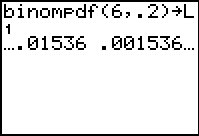Solution 11807: Demonstrating Probability Distributions on the TI-83 Plus Family of Graphing Calculators.
How can I compute the probability distributions in a binomial distribution on the TI-83 Plus family of graphing calculators?
The example below shows how to compute different probabilities in a binomial distribution.
Example:
The production of an electronic component has a large 20% defective rate. If a random selection of six components is taken,
1) What is the probability of getting exactly two defectives?
2) What is the probability of getting at most two defectives?
3) What is the probability of getting at least two defectives?
4) What is the probability of getting from two to four defectives?
Solution:
First, generate the complete distribution:.
1) Press [2nd] then [Vars] to access the
DISTR followed by [0] to select 0:binompdf(
2) Input [6] [,] [.] [2] [)].
3) Press [STO->] [2ND] [1] [ENTER] to store the answer into L1
Next, enter the values 0 to 6 into L2 to clearly identify the different probabilities by following the steps below:
1) Press [STAT].
2) Press 1: Edit.
3) Scroll over to the L2 list and press 0 [Enter] 1 [Enter] 2 [Enter] 3 [Enter] 4 [Enter] 5 [Enter] 6 [Enter]

To solve the different questions, please follow the steps below:
Question 1:
The probability of getting exactly two defectives is P(1)=.39322. This value can be found in L1. To calculate it:
1) Press [2nd] then [Vars] to access the DISTR followed by [0] to select 0:binompdf(
2) Press [6] [,] [.] [2] [,] [1] [)]
3) Press [ENTER]
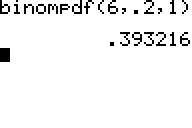
Question 2:
The probability of getting at most two defectives is P(0)+ P(1)+P(2)=.90112. To calculate it directly:
1) Press [2nd] then [Vars] followed by [ALPHA] then [Math] to access the command A:binomcdf(
2) Press [6] [,] [.] [2] [,] [2] [)]
3) Press [ENTER]
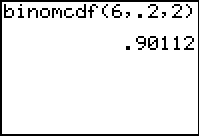
Question 3:
The probability of getting at least two defectives is P(2)+P(3)+P(4)+P(5)+P(6)=1-(P(0)+P(1))= .34464. To calculate it:
1) Press [1] [-]
2) Press [2nd] then [Vars] followed by [ALPHA] then [Math] to access the command A:binomcdf(
3) Press [6] [,] [.] [2] [,] [1] [)]
4) Press [ENTER]
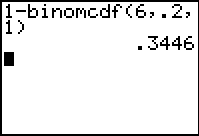
Question 4:
The probability of getting from two to four defectives is P(2)+P(3)+P(4)=.34304 =(P(0)+P(1)+P(2)+ P(3)+P(4))-(P(0)+P(1)).To calculate it:
1) Press [2nd] then [Vars] followed by [ALPHA] then [Math] to access the command A:binomcdf(
2) Press [6] [,] [.] [2] [,] [4] [)] [-]
3) Press [2nd] then [Vars] followed by [ALPHA] then [Math] to access the command A:binomcdf(
4) Press [6] [,] [.] [2] [,] [1] [)]
5) Press [ENTER].
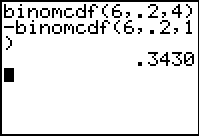
The same result can be obtained by entering sum(binompdf(6, .2,{2,3,4}))
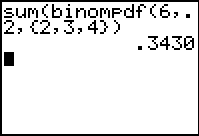
Please see the TI-83 Plus Family guidebooks for additional information.
Last updated: 7/25/2024

